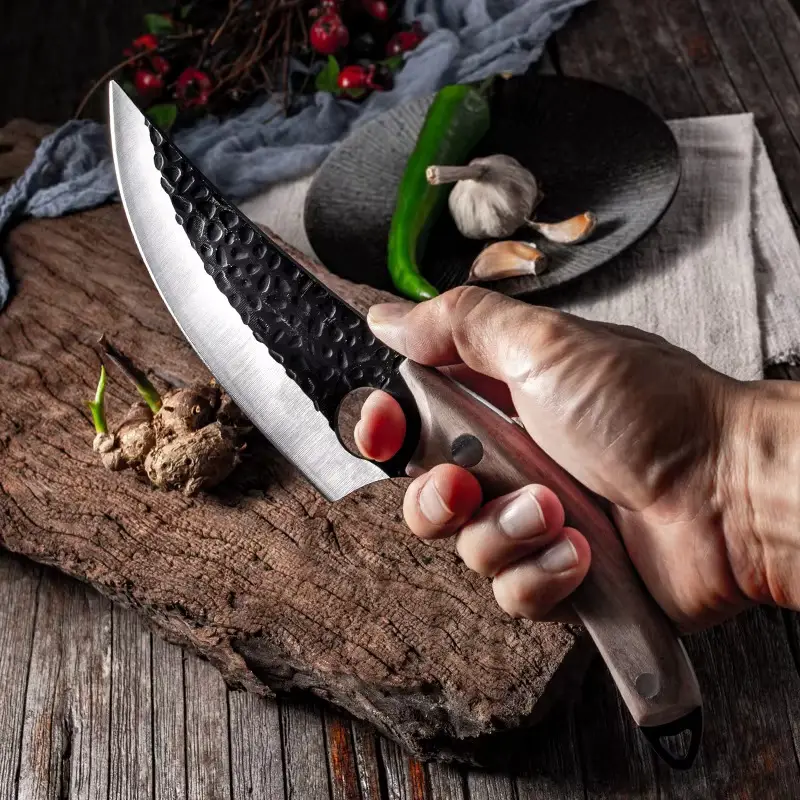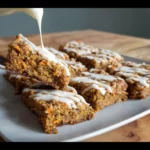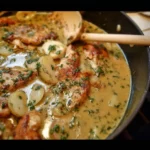There’s something truly magical about the combination of lemon, garlic, and shrimp, especially when these flavors are brought together in a comforting pasta dish. This Lemon Garlic Shrimp Pasta recipe has become a staple in my household, not only because it’s quick and easy to prepare, but also because it brings such delightful flavors and satisfaction to the table. My family absolutely adores it, and it has become their most requested meal for weeknight dinners. The tangy lemon perfectly complements the savory garlic and sweet shrimp, creating a harmonious balance that’s hard to resist. As someone who loves experimenting with flavors, this recipe ticks all the boxes for me, combining freshness, zest, and simplicity in every bite.
Ingredients
The beauty of this Lemon Garlic Shrimp Pasta lies in its simplicity and the way a few fresh ingredients can come together to create something so delicious. To start, you’ll need:
- 12 oz of your favorite pasta (I often use linguine or spaghetti)
- 1 lb of large shrimp, peeled and deveined
- 3 cloves of garlic, minced
- 2 tablespoons of olive oil
- 2 tablespoons of butter
- 1 teaspoon of red pepper flakes
- Juice and zest of 1 lemon
- Salt and pepper, to taste
- 1/4 cup of chopped fresh parsley
- Grated Parmesan cheese, for serving
These ingredients are not only easy to find in any grocery store but also lend themselves to adaptation. For instance, if you prefer a bit more heat, you might consider adding extra red pepper flakes. For those who love a creamier texture, a splash of cream can elevate the dish to new heights.
Instructions
Cooking this Lemon Garlic Shrimp Pasta is as simple as its ingredient list. Begin by bringing a large pot of salted water to a boil. Cook your pasta according to the package instructions until al dente, then drain and set aside. While the pasta is cooking, heat the olive oil and butter over medium heat in a large skillet. Add the minced garlic and sauté until fragrant, being careful not to let it burn. This should take about a minute.
Next, add the shrimp to the skillet. Season them with salt, pepper, and red pepper flakes. Cook the shrimp until they turn pink and opaque, about 2-3 minutes per side. Once cooked, remove the shrimp from the skillet and set them aside.
In the same skillet, add the lemon juice and zest, stirring to combine with the garlic and oil. Let this mixture simmer for a couple of minutes to allow the flavors to meld. Add the cooked pasta to the skillet, tossing it in the lemon-garlic sauce to ensure every strand is coated. Return the shrimp to the skillet, and stir in the chopped parsley.
Serve immediately, garnished with Parmesan cheese and additional parsley if desired. This dish is best enjoyed fresh, as the bright flavors are most pronounced.
Nutrition Facts
This recipe makes approximately four servings. Each serving contains around 450 calories, making it a balanced meal option that doesn’t skimp on flavor. With protein from the shrimp, carbohydrates from the pasta, and healthy fats from olive oil and butter, it’s a satisfying dish that doesn’t require any side accompaniments, although a simple green salad would pair nicely.
Preparation Time
One of the most appealing aspects of this Lemon Garlic Shrimp Pasta is its quick preparation time. From start to finish, you can have this meal ready in about 30 minutes. This makes it ideal for busy weeknights or when you’re entertaining guests and want to serve something impressive with minimal effort.
How to Serve
Serving a dish can elevate the dining experience, transforming a simple meal into a memorable occasion. Presentation plays a crucial role in this transformation, as it engages the senses and sets the tone for the meal. Here are several thoughtful and creative ideas to enhance the presentation and enjoyment of your dish:
1. Parmesan Cheese Garnish
A generous sprinkle of freshly grated Parmesan cheese over the top not only adds a burst of flavor but also creates an appealing visual contrast against the dish. For the best results, consider using a microplane grater to achieve a fine texture that melts slightly upon contact with the heat of the dish. This allows the cheese to integrate seamlessly into the meal, enriching each bite.
To take it a step further, you can fry some thinly shaved Parmesan into crisps to use as a crunchy garnish. Simply heat a non-stick skillet, add the shaved cheese, and cook until golden and crispy. These delightful crisps add both texture and sophistication, elevating the dish’s overall appeal. Consider serving the crisps on a small side plate or directly atop the pasta, allowing guests to enjoy both the flavor and the visual allure.
2. Garlic Bread Companion
A side of crusty garlic bread is the perfect accompaniment to soak up any remaining sauce. To prepare garlic bread, take a fresh baguette or Italian loaf, slice it in half lengthwise, and spread a mixture of softened butter, minced garlic, and chopped parsley over the cut sides. Toast it in the oven until golden brown and crispy, creating a delectable contrast to the main dish.
For an extra touch, sprinkle some sea salt or a pinch of crushed red pepper flakes on top before serving. This not only enhances flavor but also adds a rustic charm to your table setting. Consider presenting the garlic bread in a woven basket lined with a linen napkin for an inviting touch. This rustic presentation invites guests to reach for a piece, encouraging a communal dining experience.
3. Crisp Salad
A light, crisp salad with a lemon vinaigrette can complement the richness of the pasta beautifully. Consider using a mix of arugula, baby spinach, and romaine for varied textures. Toss in thinly sliced cucumbers, radishes, and bell peppers for a refreshing crunch.
For the vinaigrette, whisk together fresh lemon juice, olive oil, Dijon mustard, honey, salt, and freshly cracked black pepper. Drizzle the dressing over the salad just before serving to keep the greens vibrant and crisp. This bright side dish not only cleanses the palate but also adds a burst of color to your plate. To enhance the presentation, serve the salad in a clear glass bowl, allowing the beautiful colors and textures to be visible to your guests, or create individual servings in small mason jars for a charming, portable option.
4. Wine Pairing
A glass of chilled white wine, such as a Sauvignon Blanc or Pinot Grigio, can enhance the flavors of the dish while providing a refreshing contrast. Sauvignon Blanc, with its zesty acidity and citrus notes, pairs beautifully with creamy sauces, while Pinot Grigio offers a lighter, crisper profile that complements pasta dishes with seafood or lighter sauces.
Consider serving the wine in elegant stemware to elevate the dining experience. The clinking of glasses adds a celebratory atmosphere, and the visual appeal of fine glassware enhances the overall presentation. For a special touch, chill the wine in an ice bucket for an added element of sophistication. You might even consider preparing a simple wine tasting card that describes the wine’s notes and ideal pairings, giving your guests an interactive experience.
5. Colorful Accents
For an extra pop of color and nutrition, consider adding some cherry tomatoes or steamed asparagus on the side. Cherry tomatoes can be halved and tossed with a bit of olive oil, salt, and pepper, then roasted until caramelized for a sweet, tangy side dish. The vibrant red of the tomatoes provides a striking visual contrast against the pasta.
Steamed asparagus, drizzled with a little lemon juice and sprinkled with sea salt, offers a vibrant green contrast that enhances visual appeal while providing a fresh crunch. These colorful additions not only brighten the plate but also provide a delightful balance to the richness of the main dish. Arrange these accents artfully, perhaps leaning the asparagus against the side of the plate or grouping the roasted tomatoes in a small heap to draw the eye.
6. Presentation Tips
When serving the dish, consider the arrangement on the plate. Use a large, shallow bowl or a wide, flat plate to create an elegant presentation. Place the pasta in the center, allowing it to spill slightly over the edges for a casual yet sophisticated look. Drizzle a little extra sauce around the edges for a gourmet touch, enhancing the dish’s overall appeal.
To add depth and interest, consider employing the technique of layering. Start with a base of sauce, followed by the pasta, and finish with garnishes such as fresh herbs or a sprinkle of chili flakes. Using fresh herbs, such as basil or parsley, can add a fragrant aroma and a splash of color that invites your guests to dig in. Additionally, consider employing contrasting textures—crunchy, creamy, and tender elements all work together to create a more dynamic dining experience.
By thoughtfully considering each element of your presentation, from garnish to accompaniments, you can transform a simple meal into a delightful dining experience that will leave a lasting impression on your guests. The attention to detail in serving not only enhances the aesthetic appeal of the dish but also communicates your care and effort, making every meal a special occasion.
Additional Tips
When it comes to preparing shrimp pasta, the details can make a significant difference in the overall flavor and texture of the dish. Here are some expanded tips to help you enhance your culinary experience:
Fresh is Best
Opting for fresh shrimp whenever possible is crucial for achieving the best flavor and texture. Fresh shrimp not only have a sweeter, more delicate taste but also maintain a tender, juicy consistency that frozen shrimp may lack. When selecting fresh shrimp, look for those that are a vibrant pink hue with a slight sheen, indicating their freshness. They should also have a mild ocean scent rather than a strong fishy odor.
To further ensure quality, consider buying shrimp that are still in their shells, as this can help retain moisture and flavor until you’re ready to cook them. If fresh shrimp are unavailable, choose high-quality frozen shrimp that have been flash-frozen to preserve their freshness. Always thaw frozen shrimp in the refrigerator overnight or under cold running water to maintain their texture. Avoid thawing shrimp in warm water or at room temperature, as this can lead to uneven cooking and spoilage.
Don’t Overcook the Shrimp
Shrimp are notoriously quick to cook, often requiring only 2-5 minutes depending on their size. To achieve the perfect texture, keep a watchful eye on them as they cook. Overcooked shrimp can turn rubbery, losing their delicate flavor and appealing texture. A good indicator that shrimp are cooked is their color; they should turn from a translucent gray to an opaque white or pink.
Additionally, shrimp will curl into a C-shape when done; if they curl tightly into an O shape, they are likely overcooked. If you’re unsure, it’s better to undercook slightly and allow residual heat to finish the cooking process. For the best results, cook shrimp in a hot pan to create a slight sear, which enhances flavor through caramelization. Always remove shrimp from the heat promptly once they are done to prevent carryover cooking.
Adjust Seasoning to Taste
The bold flavors of lemon and garlic are fundamental to many shrimp pasta recipes, but personal preference plays a significant role in achieving the perfect balance. Start with the recommended amounts of lemon juice and minced garlic, then taste the dish as you go. If you desire a more pronounced garlic flavor, consider adding freshly minced garlic at the end of cooking for a sharper taste.
For those who prefer a zestier dish, a splash of lemon juice can brighten the flavors significantly. Don’t hesitate to experiment with additional seasonings such as crushed red pepper flakes for heat, fresh herbs like parsley or basil for freshness, or even a touch of white wine to deepen the flavor profile. Additionally, consider incorporating flavored oils, such as chili oil or herb-infused olive oil, to introduce new layers of taste.
Try Different Pasta
While long pasta varieties like linguine are often the go-to for shrimp dishes, the world of pasta is diverse and full of possibilities. Experimenting with different pasta shapes can introduce new textures and experiences to your meal. Fettuccine provides a wider surface area for sauce adherence, while penne can capture bits of shrimp and sauce in its tubular shape.
Consider using whole wheat or gluten-free pasta for a healthier alternative, or even stuffed pasta such as tortellini for an unexpected twist. Cooking times may vary, so be sure to adjust accordingly and taste for doneness. Additionally, consider using fresh pasta if available, as it cooks faster and offers a tender bite that can elevate the overall dish.
Make It Creamy
For those who enjoy a richer, creamier shrimp pasta dish, incorporating a splash of cream or mascarpone cheese can elevate your meal to new heights. Adding cream creates a luscious sauce that clings beautifully to the pasta, while mascarpone adds a unique creaminess and a hint of sweetness.
To achieve the perfect creamy consistency, stir in the cream or mascarpone just before serving, allowing it to melt and incorporate smoothly into the sauce. For added depth, consider infusing the cream with additional flavors, such as a pinch of nutmeg or freshly grated Parmesan cheese. This creamy variation can also serve as a base for incorporating vegetables like spinach or sun-dried tomatoes, adding both color and nutritional value to your dish.
Incorporate Fresh Vegetables
Adding seasonal vegetables to your shrimp pasta not only enhances the dish’s visual appeal but also boosts its nutritional profile. Vegetables like cherry tomatoes, zucchini, bell peppers, and asparagus can complement the shrimp beautifully. Sauté them alongside the shrimp or blanch them briefly before tossing them into the pasta.
For a more robust dish, consider roasting vegetables like broccoli or cauliflower to bring out their natural sweetness and add a slightly charred flavor. The key is to coordinate the cooking times so that all components are cooked perfectly and retain their individual textures and flavors.
Consider Flavor Pairings
Shrimp pairs well with a variety of flavors, and experimenting with different combinations can lead to delightful results. Consider adding a splash of citrus, such as orange or lime juice, to create a fresh and vibrant sauce. Alternatively, a dash of soy sauce or fish sauce can introduce an umami richness that complements the shrimp.
Herbs are also a wonderful way to enhance your dish; fresh dill, cilantro, or tarragon can offer bright notes that contrast beautifully with the richness of the pasta. For a touch of sophistication, consider finishing your dish with a drizzle of high-quality extra virgin olive oil or a sprinkle of lemon zest to amplify the flavors just before serving.
By following these comprehensive tips, you can enhance your shrimp pasta experience, ensuring a delicious and satisfying meal that highlights the natural flavors of the shrimp while allowing for creativity in your preparation. Enjoy the process and the delightful results!
FAQ Section
Q: Can I use pre-cooked shrimp for this recipe?
A: Yes, you can use pre-cooked shrimp, but be sure to add them at the end of cooking just to warm through, as they can become overcooked and rubbery if heated for too long.
Q: Can I substitute the shrimp with another protein?
A: Absolutely! This recipe works well with chicken or scallops. Just adjust the cooking time accordingly.
Q: How can I make this dish gluten-free?
A: Simply substitute the regular pasta with your favorite gluten-free pasta. Ensure all other ingredients are certified gluten-free as well.
Q: Is it possible to make this recipe dairy-free?
A: Yes, to make it dairy-free, you can replace the butter with a dairy-free alternative and omit the Parmesan cheese, or use a dairy-free cheese substitute.
Q: Can I prepare this dish in advance?
A: While it’s best served fresh, you can prepare the sauce and cook the pasta in advance. Store them separately and combine them just before serving to ensure the best texture and flavor.






